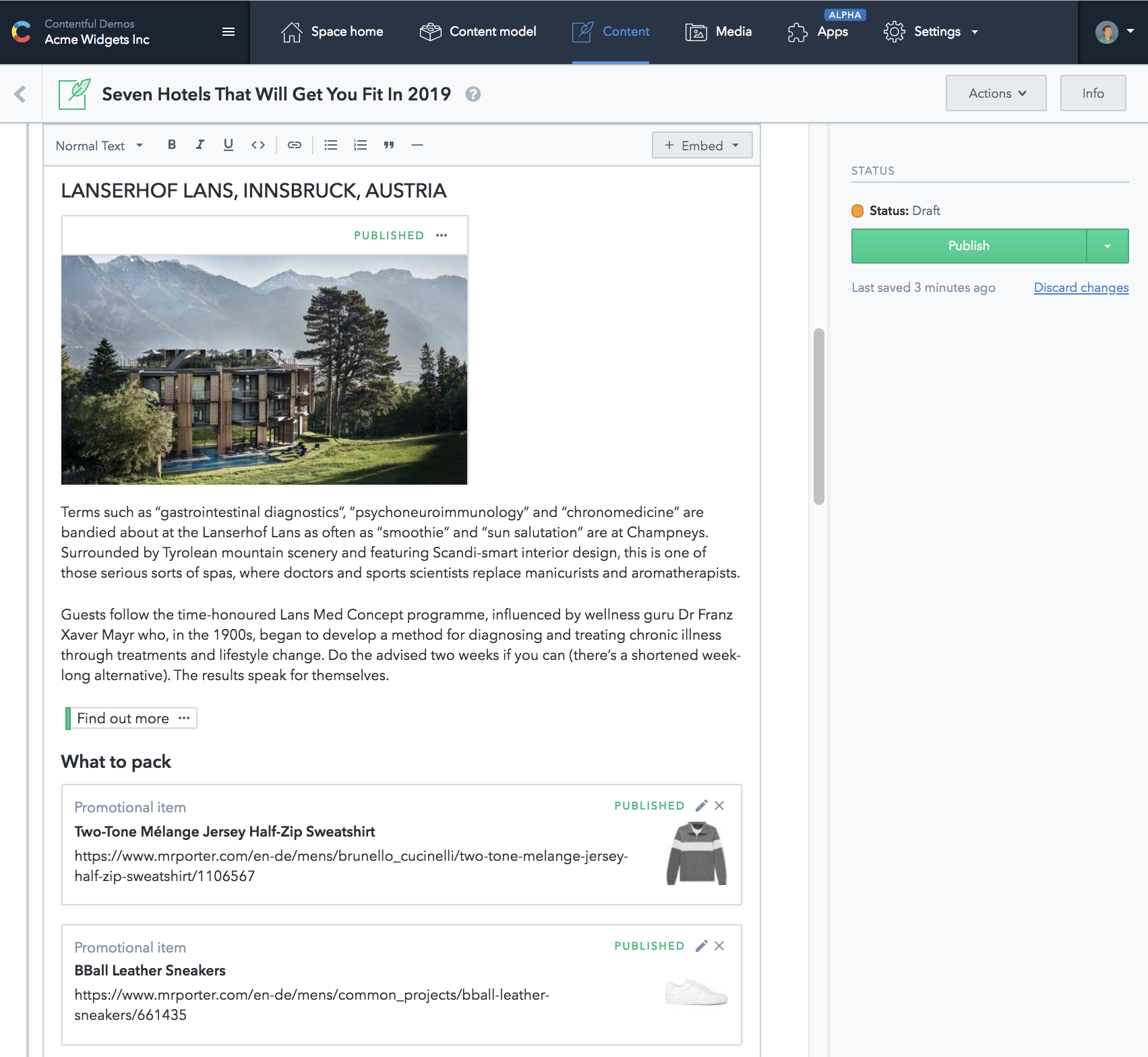Authoring hub: a modern way of unifying content operations

Organizations rely on mammoth enterprise suites or a hodgepodge of legacy tools to manage their content operations. These approaches are poorly equipped to deal with multi-channel reality, and they lack transparency. As a result, organizations either slow down and duplicate work at best, or inflate operational costs and limit oversight at worst.
Winning at content management is about enabling developers and content creators to stay flexible and minimize silos. Our winter product release focuses on core tools for enhancing the authoring experience and for deep customization of the Contentful platform. Here is what’s included:
Next-gen rich text editor: Gives practitioners a familiar way of working with content, while developers continue getting the same structured content they know and love — now everyone wins.
Custom sidebar: Helps each team or business unit be more productive by exposing the tools and data they need for different projects within their authoring environment.
Extensibility framework: Easily build, style and deploy in-app widgets and service integrations with an updated UI SDK and newly open-sourced design system.
GraphQL API: Query format enabling developers to turn siloed backends into streamlined, high-performance websites and mobile apps.
These features help Contentful customers unify content tools that are isolated across their enterprise into an authoring hub, solving three critical problems. First, content creators can now produce all their content — blogs and landing pages, in-app announcements and support resources, personalized content and event microsites — in one place. Second, teams can embed third-party tools and data-backed insights directly in their authoring environment.
Finally, developers can easily deliver content across all digital channels and customer touchpoints. By building an integrated authoring hub, organizations have a scalable way to create, optimize, deliver and otherwise streamline content operations across their projects.
Rich text editor
The traditional rich text editor is universally loved for its intuitive, point-and-click interface. We include it on our list of default editing widgets. The Contentful implementation of the rich text concept, however, comes with a number of additional capabilities.
Developers can breathe a sigh of relief. Content created in the rich text field retains its structured format, making it easy to deliver to any screen. Rich text — coupled with a well-designed content model — gives editors full creative freedom over their work. In addition to writing a copy, they can now more easily embed media, add signup forms (e.g. from Marketo), insert A/B experiments (e.g. from Optimizely) and work with dynamic text. A recent talk from Jesse Pinho, senior frontend engineer at Clue, offers an interesting case study of the many possibilities enabled by the rich text editor

Custom sidebar
More than half of Contentful customers have used some kind of extension or custom widget in their space. These run the gamut from fields with built-in SEO URL generators and label pickers to full-blown integrations serving Apple Music or Shopify merchandise results within an entry for in-context commerce.
The custom sidebar widens the list of possibilities by giving you full control of the sidebar. Extensions can also be decoupled from individual fields. Imagine tweaking the behavior of the publishing button, creating clutter-free views, running SEO checks or providing conversion metrics right inside the content creation view. This flexibility translates into more inspired, powerful editorial teams

The Gatsby preview extension provides instant builds of a page being edited within Contentful.
Extensibility framework
As Contentful offers more ways to embed extensions, we want to make sure that the experience of building extensions remains quick and straightforward. We’ve extended the scope of our UI Extension SDK, a library of pre-built functions and methods powering in-app interactions. We’ve also introduced a CLI tool for developing in-app extensions, and simplified the process for adding and configuring extensions.
Even better, we open-sourced the library of UI components used by the Contentful web app, Forma36. This move ensures that custom extensions remain visually consistent with the rest of the web app and eliminates the need to style them. For an idea of what’s possible, visit our marketplace or sign up for an upcoming webinar on all things extensibility.

The media extension uses a dialogue view to browse assets stored on the Bynder platform.
GraphQL API
After a successful beta period, the GraphQL API is now public. GraphQL forms the next generation of API design and offers a perfect complement to editorial capabilities the authoring hub offers. It’s now possible to assemble content from multiple sources and deliver it to exact frontend requirements — all with a single API call. Simple syntax and generic implementation make it easy to transform siloed data and isolated systems into intelligent and fast websites and apps.
Over the last year, we’ve been very vocal about the impact GraphQL will have on the way digital products are built. We are thrilled to finally be able to put it into the hands of our customers.

Modern, streamlined content operations
Contentful is popular with developers on high-scale digital teams because it provides a single content hub for serving content across all channels, programming languages and project types. To them, it’s a backend that can be wired up to power new projects, deliver content to new devices and configured to hold a wide range of editorial content.
Our latest release aims to provide a similar level of flexibility to content creators. Lawyers, bloggers, translators, art directors, content strategists, campaign managers, support representatives and marketers all approach content production in very different ways. But an authoring UI as a service benefits them all. We believe the transition to a single authoring hub will have a profound impact on the way organizations produce content.
Explore Contentful yourself by requesting a demo.


